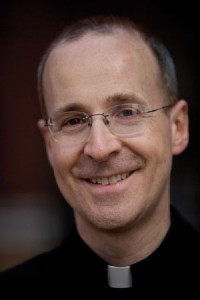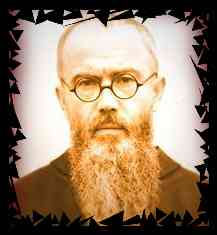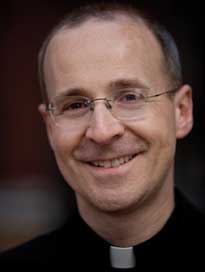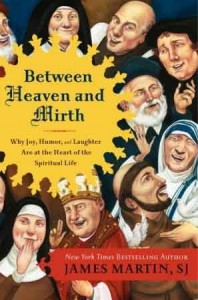
Join Bruce and I, as we discuss the life of both St. Maximilian Kolbe and St. Teresa Benedicta of the Cross with Fr. James Martin, S.J.
[powerpress]
 Just look at his eyes…every picture of St. Maximillan Kolbe has those fiery prophetic eyes.
Just look at his eyes…every picture of St. Maximillan Kolbe has those fiery prophetic eyes.
Fueled with the fires of grace from his great love for and devotion to the Blessed Virgin Mary, St. Maximilian was a missionary extraordinaire. A publisher who was a leader in the yet to be defined “New Evangelization”.
They say the blood of the martyrs becomes the seed for the Church. In the case of St. Maximilian, Catholic publishing and broadcasting…all media, would be enriched by his intercession and example. His courage in speaking out against the horrors of the Nazi regime is what placed him in the death camp; it would be his love for Christ and his neighbor that would lead him to give his life for another. And that is what earned him the martyr’s crown.
“In order to discourage escapes, Auschwitz had a rule that if a man escaped, ten men would be killed in retaliation. In July 1941 a man from Kolbe’s bunker escaped. The dreadful irony of the story is that the escaped prisoner was later found drowned in a camp latrine, so the terrible reprisals had been exercised without cause. But the remaining men of the bunker were led out.
‘The fugitive has not been found!’ the commandant Karl Fritsch screamed. ‘You will all pay for this. Ten of you will be locked in the starvation bunker without food or water until they die.’ The prisoners trembled in terror. A few days in this bunker without food and water, and a man’s intestines dried up and his brain turned to fire.
The ten were selected, including Franciszek Gajowniczek, imprisoned for helping the Polish Resistance. He couldn’t help a cry of anguish. ‘My poor wife!’ he sobbed. ‘My poor children! What will they do?’ When he uttered this cry of dismay, Maximilian stepped silently forward, took off his cap, and stood before the commandant and said, ‘I am a Catholic priest. Let me take his place. I am old. He has a wife and children.’
Astounded, the icy-faced Nazi commandant asked, ‘What does this Polish pig want?’
Father Kolbe pointed with his hand to the condemned Franciszek Gajowniczek and repeated‘I am a Catholic priest from Poland; I would like to take his place, because he has a wife and children.’
Observers believed in horror that the commandant would be angered and would refuse the request, or would order the death of both men. The commandant remained silent for a moment. What his thoughts were on being confronted by this brave priest we have no idea. Amazingly, however, he acceded to the request. Apparantly the Nazis had more use for a young worker than for an old one, and was happy to make the exchange. Franciszek Gajowniczek was returned to the ranks, and the priest took his place.
Gajowniczek later recalled:
 I could only thank him with my eyes. I was stunned and could hardly grasp what was going on. The immensity of it: I, the condemned, am to live and someone else willingly and voluntarily offers his life for me – a stranger. Is this some dream?
 I was put back into my place without having had time to say anything to Maximilian Kolbe. I was saved. And I owe to him the fact that I could tell you all this. The news quickly spread all round the camp. It was the first and the last time
For that such an incident happened in the whole history of Auschwitz. A long time I felt remorse when I thought of Maximilian. By allowing myself to be saved, I had signed his death warrant. But now, on reflection, I understood that a man like him could not have done otherwise. Perhaps he thought that as a priest his place was beside the condemned men to help them keep hope. In fact he was with them to the last.’‘
A personal testimony about the way Maximilian Kolbe met death is given by Bruno Borgowiec, one of the few Poles who were assigned to render service to the starvation bunker. He told it to his parish priest before he died in 1947:
 ‘The ten condemned to death went through terrible days. From the underground cell in which they were shut up there continually arose the echo of prayers and canticles. The man in-charge of emptying the buckets of urine found them always empty. Thirst drove the prisoners to drink the contents. Since they had grown very weak, prayers were now only whispered. At every inspection, when almost all the others were now lying on the floor, Father Kolbe was seen kneeling or standing in the centre as he looked cheerfully in the face of the SS men.
Father Kolbe never asked for anything and did not complain, rather he encouraged the others, saying that the fugitive might be found and then they would all be freed. One of the SS guards remarked: this priest is really a great man. We have never seen anyone like him ..
Two weeks passed in this way. Meanwhile one after another they died, until only Father Kolbe was left. This the authorities felt was too long. The cell was needed for new victims. So one day they brought in the head of the sick-quarters, a German named Bock, who gave Father Kolbe an injection of carbolic acid in the vein of his left arm. Father Kolbe, with a prayer on his lips, himself gave his arm to the executioner. Unable to watch this I left under the pretext of work to be done. Immediately after the SS men had left I returned to the cell, where I found Father Kolbe leaning in a sitting position against the back wall with his eyes open and his head drooping sideways. His face was calm and radiant ..’
 So it was that Father Maximilian Kolbe was executed on 14 August, 1941 at the age of forty-seven years, a martyr of charity. The death certificate, as always made out with German precision, indicated the hour of death 12.30.
Father Kolbe’s body was removed to the crematorium, and without dignity or ceremony was disposed of, like hundreds of thousands who had gone before him, and hundreds of thousands more who would follow.
The heroism of Father Kolbe went echoing throughAuschwitz. In that desert of hatred he had sown love. A survivor Jozef Stemler later recalled: ‘In the midst of a brutalization of thought, feeling and words such as had never before been known, man indeed became a ravening wolf in his relations with other men. And into this state of affairs came the heroic self-sacrifice of Father Kolbe.’ Another survivor Jerzy Bielecki declared that Father Kolbe’s death was ‘a shock filled with hope, bringing new life and strength … It was like a powerful shaft of light in the darkness of the camp.’
The cell where Father Kolbe died is now a shrine. Maximilian Kolbe was beatified as Confessor by Paul VI in 1970, and canonized as Martyr by Pope John Paul II in 1981.†– from St. Maximillian Kolbe, saint of Auschwitz
Tags: auschwitz, blessed virgin mary, catholic, catholic podcast, catholic prayer, catholic priest, cathollc spirituality, children, edith stein, father kolbe, fr. james martin, holacaust, James Martin, martyrs, maximillan kolbe, Maximillian Kolbe, nazi death camp, st maximilian
This entry was posted on Thursday, August 14th, 2014 at 6:01 pm
You can follow any responses to this entry through the RSS 2.0 feed.
 Here is a special interview we had with Fr. James Martin, SJ discussing St. Ignatius of Loyola
Here is a special interview we had with Fr. James Martin, SJ discussing St. Ignatius of Loyola
[powerpress]
ADDRESS OF HIS HOLINESS BENEDICT XVI
TO THE FATHERS AND BROTHERS OF THE SOCIETY OF JESUS
Vatican Basilica
Saturday, 22 April 2006 Â from vatican.va
Dear Fathers and Brothers of the Society of Jesus,
I meet you with great joy in this historical Basilica of St Peter’s after the Holy Mass celebrated for you by Cardinal Angelo Sodano, my Secretary of State, on the occasion of combined jubilees of the Ignatian Family. I address my cordial greeting to you all.
I greet in the first place the Superior General, Fr Peter-Hans Kolvenbach, and thank him for his courteous words expressing your common sentiments to me. I greet the Cardinals with the Bishops and priests and all those who have desired to participate in this event.
Together with the Fathers and Brothers, I also greet the friends of the Society of Jesus present here, and among them, the
many men and women religious, members of the Communities of Christian Life and of the Apostolate of Prayer, the students and alumnae with their families from Rome, from Italy and from Stonyhurst in England, the teachers and students of the academic institutions and the many collaborators.
Your visit today gives me the opportunity to thank the Lord with you for having granted your Society the gift of men of extraordinary holiness and exceptional apostolic zeal, such as St Ignatius of Loyola, St Francis Xavier and Bl. Peter Faber. For you they are the Fathers and Founders: it is therefore appropriate that in this centenary year you commemorate them with gratitude and look to them as enlightened and reliable guides on your spiritual journey and in your apostolic activities.
St Ignatius of Loyola was first and foremost a man of God who in his life put God, his greatest glory and his greatest service, first. He was a profoundly prayerful man for whom the daily celebration of the Eucharist was the heart and crowning point of his day.
Thus, he left his followers a precious spiritual legacy that must not be lost or forgotten. Precisely because he was a man of God, St Ignatius was a faithful servant of the Church, in which he saw and venerated the Bride of the Lord and the Mother of Christians. And the special vow of obedience to the Pope, which he himself describes as “our first and principal foundation” (MI, Series III, I., p. 162), was born from his desire to serve the Church in the most beneficial way possible. (more…)
Tags: american magazine, celebration, fr. james martin, heart, James Martin, st. ignatius, st. ignatius of loyola
This entry was posted on Wednesday, July 31st, 2013 at 1:45 am
You can follow any responses to this entry through the RSS 2.0 feed.
I LOVE talking with Fr. James Martin, especially about the saints!  “Between Heaven and Mirth: Why Joy, Humor, and Laughter Are at the Heart of the Spiritual Life” is fantastic! I don’t think there’s another book like it out there. Fr. Martin takes Scripture, history, the Saints, and the basics of our faith and the spiritual life, and wraps them  all together to bring us a unique and wonderful study of joy and happiness. To say it was uplifting to read would be an understatement.  Others have tried to write humorous books about the Christian faith, but often times their attempts come  off little crass and a tad tasteless….but not Fr. Jim Martin, that’s because it about joy, happiness and grace…and he leads to the well where we can find it.  [powerpress]
Humor, and Laughter Are at the Heart of the Spiritual Life” is fantastic! I don’t think there’s another book like it out there. Fr. Martin takes Scripture, history, the Saints, and the basics of our faith and the spiritual life, and wraps them  all together to bring us a unique and wonderful study of joy and happiness. To say it was uplifting to read would be an understatement.  Others have tried to write humorous books about the Christian faith, but often times their attempts come  off little crass and a tad tasteless….but not Fr. Jim Martin, that’s because it about joy, happiness and grace…and he leads to the well where we can find it.  [powerpress]
You can find the book here
Tags: catholic, catholic podcast, catholic prayer, cathollc spirituality, fr. james martin, humor, James Martin, Jim Martin, Mirth, saints
This entry was posted on Wednesday, October 5th, 2011 at 10:19 am
You can follow any responses to this entry through the RSS 2.0 feed.

